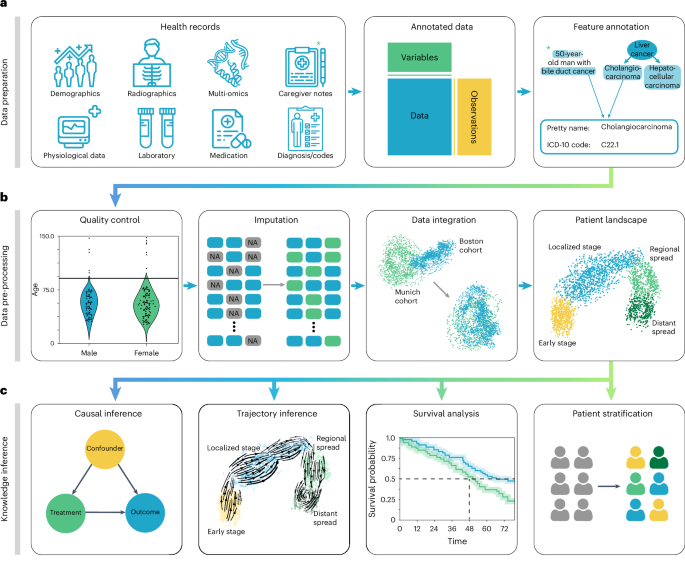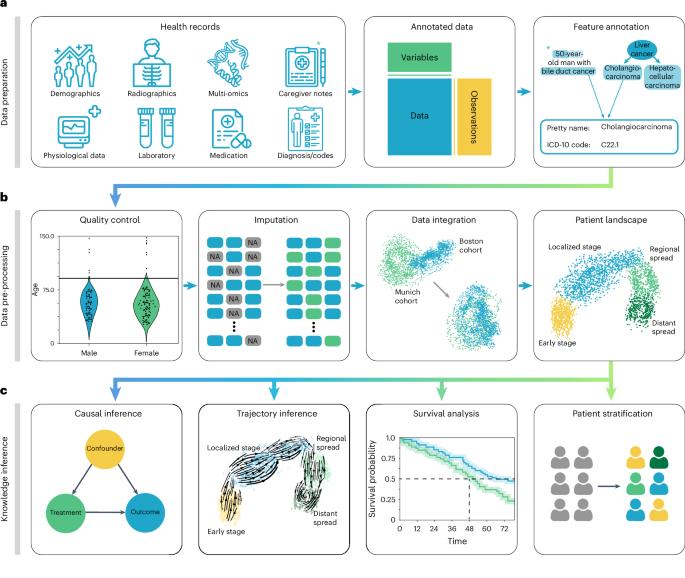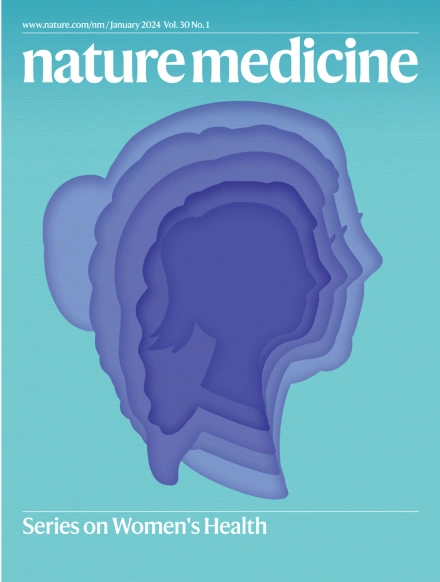用于端到端分析电子健康记录数据的开源框架
IF 58.7
1区 医学
Q1 BIOCHEMISTRY & MOLECULAR BIOLOGY
引用次数: 0
摘要
随着全球医疗系统的逐步数字化,大规模收集电子健康记录(EHR)已成为普遍现象。然而,目前还缺少一个考虑到数据异质性的可扩展的综合探索性分析框架。ehrapy 包含一系列分析步骤,从数据提取和质量控制到生成低维表示。辅以丰富的统计模块,ehrapy 可帮助将患者与疾病状态关联起来、对患者集群进行差异比较、生存分析、轨迹推断、因果推断等。利用本体,ehrapy 还能进一步实现数据共享和训练 EHR 深度学习模型,为生物医学研究中的基础模型铺平道路。我们在六个不同的例子中展示了 ehrapy 的功能。我们应用 ehrapy 将不明肺炎患者分层为更精细的表型。此外,我们还揭示了这些群体间生存率显著差异的生物标志物。此外,我们还量化了肺炎药物对住院时间的影响。我们进一步利用 ehrapy 分析了不同数据模式下的心血管风险。我们根据成像数据重建了严重急性呼吸系统综合征冠状病毒 2(SARS-CoV-2)患者的疾病状态轨迹。最后,我们进行了一项案例研究,展示了 ehrapy 如何检测和减轻电子病历数据中的偏差。因此,我们认为 ehrapy 提供的框架将使电子病历数据的分析管道标准化,并成为社区的基石。本文章由计算机程序翻译,如有差异,请以英文原文为准。


An open-source framework for end-to-end analysis of electronic health record data
With progressive digitalization of healthcare systems worldwide, large-scale collection of electronic health records (EHRs) has become commonplace. However, an extensible framework for comprehensive exploratory analysis that accounts for data heterogeneity is missing. Here we introduce ehrapy, a modular open-source Python framework designed for exploratory analysis of heterogeneous epidemiology and EHR data. ehrapy incorporates a series of analytical steps, from data extraction and quality control to the generation of low-dimensional representations. Complemented by rich statistical modules, ehrapy facilitates associating patients with disease states, differential comparison between patient clusters, survival analysis, trajectory inference, causal inference and more. Leveraging ontologies, ehrapy further enables data sharing and training EHR deep learning models, paving the way for foundational models in biomedical research. We demonstrate ehrapy’s features in six distinct examples. We applied ehrapy to stratify patients affected by unspecified pneumonia into finer-grained phenotypes. Furthermore, we reveal biomarkers for significant differences in survival among these groups. Additionally, we quantify medication-class effects of pneumonia medications on length of stay. We further leveraged ehrapy to analyze cardiovascular risks across different data modalities. We reconstructed disease state trajectories in patients with severe acute respiratory syndrome coronavirus 2 (SARS-CoV-2) based on imaging data. Finally, we conducted a case study to demonstrate how ehrapy can detect and mitigate biases in EHR data. ehrapy, thus, provides a framework that we envision will standardize analysis pipelines on EHR data and serve as a cornerstone for the community. Incorporating a series of analytical steps, from data extraction and quality control to the generation of low-dimensional representations and to longitudinal analyses, an open-source software is proposed to standardize current electronic health record data processing and analysis pipelines.
求助全文
通过发布文献求助,成功后即可免费获取论文全文。
去求助
来源期刊

Nature Medicine
医学-生化与分子生物学
CiteScore
100.90
自引率
0.70%
发文量
525
审稿时长
1 months
期刊介绍:
Nature Medicine is a monthly journal publishing original peer-reviewed research in all areas of medicine. The publication focuses on originality, timeliness, interdisciplinary interest, and the impact on improving human health. In addition to research articles, Nature Medicine also publishes commissioned content such as News, Reviews, and Perspectives. This content aims to provide context for the latest advances in translational and clinical research, reaching a wide audience of M.D. and Ph.D. readers. All editorial decisions for the journal are made by a team of full-time professional editors.
Nature Medicine consider all types of clinical research, including:
-Case-reports and small case series
-Clinical trials, whether phase 1, 2, 3 or 4
-Observational studies
-Meta-analyses
-Biomarker studies
-Public and global health studies
Nature Medicine is also committed to facilitating communication between translational and clinical researchers. As such, we consider “hybrid” studies with preclinical and translational findings reported alongside data from clinical studies.
 求助内容:
求助内容: 应助结果提醒方式:
应助结果提醒方式:


